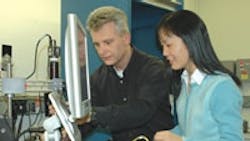Technologies Of The Year -- Defying Moore's Law
IBM researchers have built the first complex electronic integrated circuit around a single carbon nanotube molecule, a new material that shows promise for enhancing performance over today's standard silicon semiconductors.
For some 50 years the semiconductor industry has relied on the ability to pack increasing numbers of electronic circuits on a single silicon chip to make those chips more powerful, note IBM researchers Joerg Appenzeller and Zhihong Chen of T.J. Watson Research Center, Yorktown Heights, N.Y. That was achieved largely by finding ways to build circuits smaller. With scientists seeing an end to that capability looming, nanotechnology is being explored as a means to keep the industry moving forward, adds Appenzeller.
IBM built the demonstration circuit with standard semiconductor processes, Appenzeller says. A single molecule is the base for all components in the circuit, rather than linking individually constructed components. That can simplify manufacturing and provide the consistency needed to more thoroughly test and adjust the material for use, he explains.
The circuit built by the IBM team is a ring oscillator -- a circuit that chip makers typically build to evaluate new manufacturing processes or materials. The circuit stresses certain properties that can give a good indication of how the new technologies will perform when used to build complete chips, adds Appenzeller.
Columbia University collaborator Shalom Wind helped research the deposition of the gate dielectric, the insulation that separates the gate which controls current flow through the transistor from the actual nanotube channel. Andrew Rinzler, a University of Florida professor, helped with growing the right type of carbon nanotubes.
